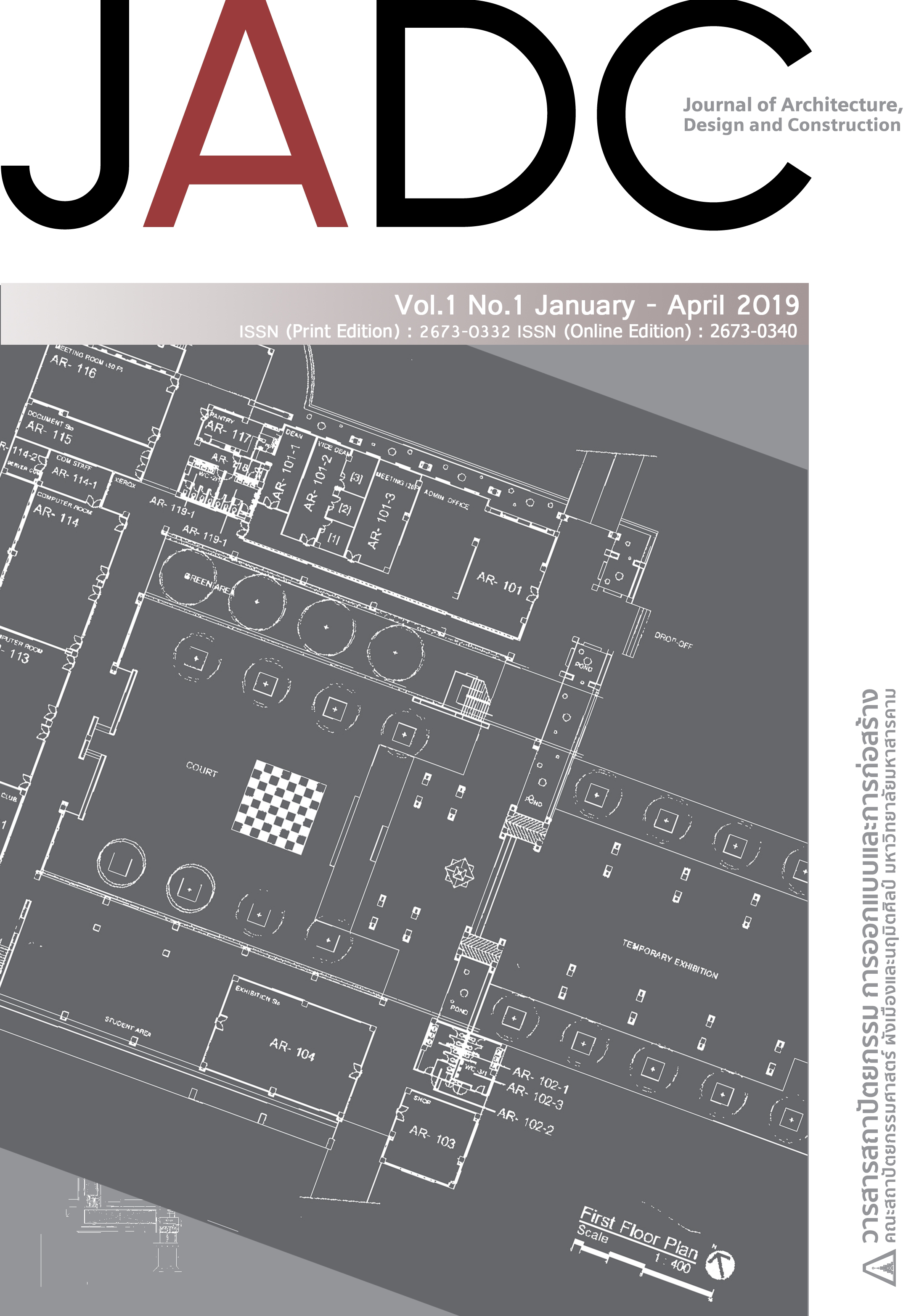โมเดลสมการโครงสร้างหลักธรรมภิบาลในการจัดซื้อจัดจ้างภาครัฐ
Main Article Content
บทคัดย่อ
การวิจัยนี้มีวัตถุประสงค์เพื่อศึกษาลักษณะโมเดลสมการโครงสร้างหลักธรรมภิบาลในการจัดซื้อจัดจ้างภาครัฐ เป็นการวิจัยเชิงสหสัมพันธ์ (Correlational research) เครื่องมือที่ใช้ในการวิจัย คือ แบบสอบถาม ซึ่งเก็บรวบรวมข้อมูลจากกลุ่มตัวอย่างหน่วยงานภาครัฐ จำนวน 353 คน วิเคราะห์ข้อมูลด้วยโปรแกรมสำเร็จรูป SPSS Version 20 และ AMOS Version 6.0 การศึกษา พบว่าลักษณะ โมเดลสมการโครงสร้างหลักธรรมภิบาลในการจัดซื้อจัดจ้างภาครัฐ มีความสัมพันธ์เชิงสาเหตุระดับนัยสำคัญทางสถิติ 0.05 นอกจากนี้ตัวแบบมีความสอดคล้องกับข้อมูลเชิงประจักษ์ 66.8 ตามลำดับ
Downloads
Article Details
บทความที่ได้รับการตีพิมพ์เป็นลิขสิทธิ์ของวารสารสถาปัตยกรรม การออกแบบและการก่อสร้าง คณะสถาปัตยกรรมศาสตร์ ผังเมืองและนฤมิตศิลป์ มหาวิทยาลัยมหาสารคาม
เอกสารอ้างอิง
กริช แรงสูงเนิน. (2554). การวิเคราะห์ปัจจัยด้วย SPSS และ Amos เพื่อการวิจัย. กรุงเทพฯ: ซีเอ็ดยูเคชั่น.
ชัยวิชิต เชียรชนะ. (2558). การใช้สถิติหลายตัวแปรเพื่อการวิจัย: การออกแบบ การวิเคราะห์ และการตีความหมาย. กรุงเทพฯ: ศูนย์หนังสือจุฬาลงกรณ์มหาวิทยาลัย.
ทิวากร แก้วมณี. (2559). Good Governance (ธรรมาภิบาล), World Order (ระเบียบโลก), และตัวแบบการพัฒนาเศรษฐกิจและสังคมของไทย. กรุงเทพฯ: สาขาวิชารัฐศาสตร์และรัฐประศาสนศาสตร์ คณะสังคมศาสตร์ มหาวิทยาลันเรศวร.
ธนายุทธ ไชยธงรัตน์ และณรงค์ เหลืองบุตรนาค. (2560). การปรับปรุงรูปแบบการจัดซื้อจัดจ้างงานก่อสร้างของหน่วยงานราชการไทยในบริบท AEC. วิทยานิพนธ์ปริญญาปรัชญาดุษฎีบัณฑิต สาขาวิชาวิศวกรรมโยธา บัณฑิตวิทยาลัยมหาวิทยาลัยขอนแก่น.
ธานินทร์ ศิลป์ จารุ. (2555). การวิจัยและวิเคราะห์ข้อมูลทางสถิติด้วย SPSS. พิมพ์ครั้งที่ 11. กรุงเทพฯ: บิสซิเนสอาร์แอนด์ดี.
บุษบง ชัยเจริญวัฒนะ และบุญมี ลี้. (2550). รายงานการวิจัยตัวชี้วัดธรรมาภิบาล. พิมพ์ครั้งที่ 3. กรุงเทพมหานคร: สถาบัญพระปกเกล้า.
พระราชบัญญัติการจัดซื้อจัดจ้างภาครัฐ. (2560). ราชกิจจานุเบกษา. เล่ม 134 (ตอนที่ 24 ก).
ยุทธ ไกยวรรณ์. (2556). การวิเคราะห์โมเดลสมการโครงสร้างด้วย Amos. กรุงเทพฯ:สำนักพิมพ์แห่งจุฬาลงกรณ์มหาวิทยาลัย.
ระพินทร์ โพธิ์ศรี. (2551). สถิติเพื่อการวิจัย = Statistics for research. พิมพ์ครั้งที่ 2. กรุงเทพฯ: สำนักพิมพ์แห่งจุฬาลงกรณ์มหาวิทยาลัย.
สมาคมส่งเสริมสถาบันกรรมการบริษัทไทย. (2006). หลักการกำกับดูแลกิจการของ OECD. กรุงเทพฯ: สมาคมส่งเสริมสถาบันกรรมการบริษัทไทย.
สำนักงานคณะกรรมการพัฒนาระบบราชการ. (2552). คู่มือการจัดระดับการกำกับดูแลองค์กรภาครัฐ ตามหลักธรรมาภิบาล ของการบริหารกิจการบ้านเมืองที่ดี. กรุงเทพฯ: บริษัท พรีเมียร์ โปร จำกัด.
Andy, f. (2013). Discovering statistics using IBM SPSS statistics. 4 edition. SAGE. ; London EC1Y 1SP.
Brand, H. (2007). Good governance for the public’s health. European. Journal of Public Health, 17(6), [Online]. Retrieved from: https://doi.org/10.1093/eurpub/ckm104 [accessed 26 August 2018].
Elkington, J. (2006). Governance for sustainability. Corp. Govern.Int. Rev, 14(6), 522-529.
Concha, G. Astudillo, H. Porrúa, M., & Pimenta, C. (2012). E-Government procurement observatory, maturity model and early measurements. Government Information Quarterly, 29(1), 43–50.
Curtin University of Technology. (2007). International Survey of E-procurement Systems. World Bank Publication. [Online]. Retrieved from: http://idbdocs.iadb.org/wsdocs/getdocument.aspx?doc num=1064452 [accessed 26 August 2018].
Graham, J. Amos, B., & Plumptre, T. (2003). Principles for Good Governance in the 21st Century. Policy Brief No 15, Canada: Institute on Governance.
Helmut, B. (2007). Good governance for the public’s health. Oxford University Press on behalf of the European Public Health Association.
Kaufmann, D. Kraay, A., & Mastruzzi, M. (2010). The Worldwide Governance Indicators: Methodology and Analytical Issues. World Bank Policy Research Working.
Lachit, C. (2013). Good Governance: Context of Thailand. Romphruek Journal, 2(1), February-May 2013, 78-98.
Lynn, Jr. L.E., Heinrich T., & C. Hill, J. (2001). Improving Governance a New Logic for Empirical Research. Washington, D.C.: Georgetown University Press.
Maldonado, N. (2010). The World Bank’s Evolving Concept of Good Governance and its Impact on Human Rights. Bonn: University of Bonn, Germany.
Narong L., Tanayut C., & Preenithi A. (2018). An Exploratory Factor Analysis of Government Construction Procurement Problems. MATEC Web of Conferences. 192, 02057 (2018) [Online]. Retrieved from: https://doi.org/10.1051/matecconf/201819202057 [accessed 26 August 2018].
Neupane, A., Soar, J., Vaidya, K., & Yong, J. (2012). The potential of e-procurement technology for reducing corruption. International Journal of Information Technology and Management, 11(4), 273-287.
Sabel, C.F. (1993). Constitutional Ordering in Historical Context. in Games in Hierarchies and Networks : Analytical and Empirical Approaches to the Study of Governance Institutions, Edited by F.W. Scharpf. Boulder Colo. : Westview Press.
Tanayut C., Narong L., Preenithi A., & Patrick M. (2017). Application of Confirmatory Factor Analysis in Government Construction Procurement Problems in Thailand. International Transaction Journal of Engineering, Management & Applied Sciences & Technologies., 8(3), 221-231.
Trkman, P., & McCormack, K. (2010). Estimating the benefits and risks of implementing e-procurement. IEEE Trasactions on Engineering Management, 57(2), 338-349.
Vaidya K., Callender G., Sajeev A.S.M., & Gao J.B. (2004). Towards a Model for Measuring the Performance of e-Procurement Initiatives in the Australian Public Sector: A Balanced Scorecard Approach, Australian e-Governance Conference, April 14-15, Melbourne.
W.Lawrence Neuman. (2006). Social research methods: qualitative and quantitative approaches. 6th ed. Printed in United States of America.
WTO. (2012). Agreement on Government Procurement. USA: The University of Michigan Press.


